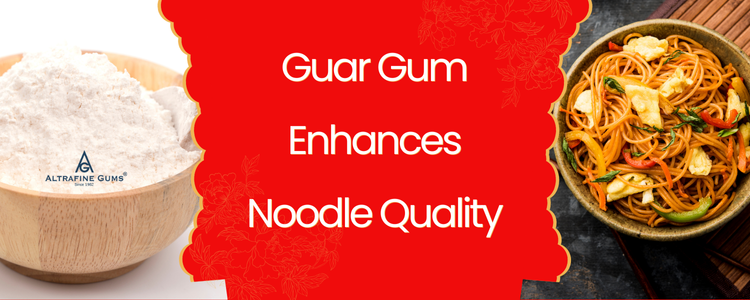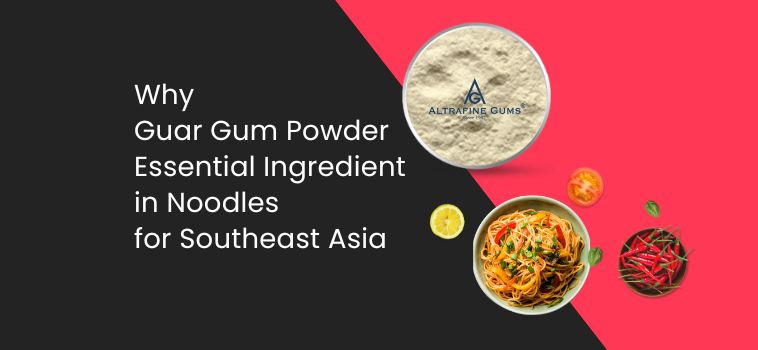Noodles are a staple food in many Southeast Asian countries, known for their versatility, texture, and ability to absorb flavors. The demand for high-quality noodles has increased due to consumer preferences for improved texture, longer shelf life, and enhanced cooking stability. Guar gum powder, a natural thickener and stabilizer, plays a crucial role in noodle production. It enhances the elasticity, texture, and shelf life of noodles while providing cost-effective solutions for manufacturers.
How Guar Gum Enhances Noodle Quality
Guar gum provides multiple benefits in noodle manufacturing, making it a preferred ingredient in Southeast Asian markets.
- Improves Texture and Elasticity: Enhances the chewiness and resilience of noodles, preventing breakage during cooking.
- Enhances Water Absorption: Allows noodles to retain moisture, improving their mouthfeel and consistency.
- Prevents Sticking and Clumping: Ensures that noodles maintain their individual strands instead of forming lumps.
- Extends Shelf Life: Reduces the degradation of noodles over time by maintaining structural integrity.
- Improves Freeze-Thaw Stability: Ensures noodles remain intact even after freezing and reheating, important for instant and frozen noodle products.
- Boosts Yield in Production: Helps manufacturers optimize flour-to-noodle conversion, improving production efficiency.
- Enhances Nutritional Value: As a plant-based ingredient, guar gum supports clean-label formulations preferred by health-conscious consumers.
- Reduces Oil Absorption: Helps lower fat content in deep-fried instant noodles by creating a moisture barrier.

Noodle Manufacturing in Southeast Asia: Why Guar Gum is Preferred
Southeast Asian countries have distinct noodle varieties, each requiring specific textural properties. Guar gum helps maintain these unique characteristics while improving production efficiency.
- Thailand: Rice noodles and glass noodles benefit from guar gum as a thickener to improve structure and prevent excessive softness. Popular dishes like Pad Thai rely on the right noodle texture for an authentic experience.
- Vietnam: Traditional Pho noodles require elasticity and chewiness, which guar gum enhances. It also improves the hydration of fresh noodles, making them more resistant to overcooking.
- Indonesia: Used in wheat and egg noodles to prevent starch retrogradation and improve bite resistance. Instant noodles, a major part of the Indonesian diet, use guar gum to maintain consistency after cooking.
- Malaysia: Popular in Halal-certified noodles, where guar gum acts as a plant-based stabilizer that aligns with dietary regulations.
- Philippines: Essential in instant noodle manufacturing, where guar gum improves rehydration properties and prevents over-swelling. Dishes like Pancit Canton benefit from improved noodle strength.
The Role of Guar Gum in Different Types of Noodles
Noodle production varies depending on the type and intended usage. Guar gum is useful in multiple noodle categories:
- Fresh Noodles: Improves stretchability, making it easier to roll and cut without breakage.
- Dried Noodles: Enhances the structural integrity, preventing noodles from becoming brittle.
- Instant Noodles: Aids in fast rehydration while maintaining elasticity.
- Gluten-Free Noodles: Provides a binding alternative to wheat gluten, improving the texture of rice-based or other non-wheat noodles.
- Frozen Noodles: Prevents ice crystal formation and maintains elasticity after thawing.
Comparison of Guar Gum with Other Binders
Guar gum is widely used in the food industry, but how does it compare to other common binders?
- Guar Gum vs. Xanthan Gum: Guar gum provides better thickening properties, while xanthan gum excels in stabilizing emulsions. Guar gum is more cost-effective for noodle applications.
- Guar Gum vs. Locust Bean Gum: While both gums enhance elasticity, guar gum hydrates faster and is more effective in small concentrations.
- Guar Gum vs. Tapioca Starch: Tapioca starch provides viscosity but lacks the water-binding and freeze-thaw stability of guar gum.
- Guar Gum vs. Cornstarch: Cornstarch thickens but can become brittle over time, whereas guar gum retains elasticity and flexibility.
- Guar Gum vs. Modified Starches: Modified starches offer similar thickening effects, but guar gum is preferred due to its clean-label and natural origin.
How Manufacturers Use Guar Gum in Large-Scale Production
- In Dough Mixing: Guar gum is blended with flour to enhance hydration and elasticity.
- During Drying Process: Maintains the structure of noodles and prevents excessive drying.
- For Instant Noodles: Helps in controlling expansion during frying or dehydration to ensure proper rehydration later.
- In Gluten-Free Formulations: Guar gum replaces gluten to provide the necessary elasticity and mouthfeel.
Future Trends in the Southeast Asian Noodle Market
The noodle industry in Southeast Asia is evolving with changing consumer preferences and advancements in food technology. Guar gum is expected to play a significant role in these trends:
- Growth of Instant and Ready-to-Eat Noodles: With urbanization, the demand for convenient food options is increasing, and guar gum enhances the stability and shelf life of these products.
- Expansion of Gluten-Free Noodles: With rising awareness of gluten intolerance, guar gum provides a plant-based thickener for gluten-free noodles.
- Sustainability and Clean Label Products: Manufacturers are shifting towards natural ingredients, and guar gum, being plant-derived, meets the demand for clean-label noodles.
- Innovation in Frozen and Chilled Noodles: With improved freeze-thaw stability, guar gum helps frozen and refrigerated noodles maintain their texture after reheating.
- Increasing Exports of Southeast Asian Noodles: The global market for Asian noodles is expanding, and guar gum helps manufacturers meet international quality standards.
- Consumer Shift Towards Healthier Alternatives: Guar gum reduces the need for artificial additives, making it a key ingredient in functional foods.
Frequently Asked Questions (FAQs) About Guar Gum Powder
Why is guar gum used in noodle manufacturing?
Guar gum improves texture, elasticity, moisture retention, and freeze-thaw stability, making it essential for noodle production.
Does guar gum affect the taste of noodles?
No, guar gum is neutral in flavor and does not alter the taste of noodles.
Is guar gum safe for gluten-free noodles?
Yes, guar gum is gluten-free and commonly used in gluten-free noodle formulations.
How does guar gum improve instant noodle quality?
It enhances rehydration, prevents clumping, and improves the shelf stability of instant noodles.
Can guar gum be used in fresh and dried noodles?
Yes, guar gum is used in both fresh and dried noodles to maintain texture and prevent brittleness.
What makes guar gum better than other thickeners for noodles?
It provides superior water retention, elasticity, and stability at a lower cost compared to alternative binders.
How does guar gum impact the cost-effectiveness of noodle production?
By improving yield, reducing waste, and extending shelf life, guar gum helps manufacturers lower production costs.
Is guar gum suitable for organic noodle production?
Yes, guar gum is a natural, plant-based ingredient that can be used in organic-certified noodles.
Guar gum continues to be an essential ingredient in the Southeast Asian noodle market, helping manufacturers improve quality, efficiency, and sustainability. Let me know if you need any refinements before proceeding with the next article!

